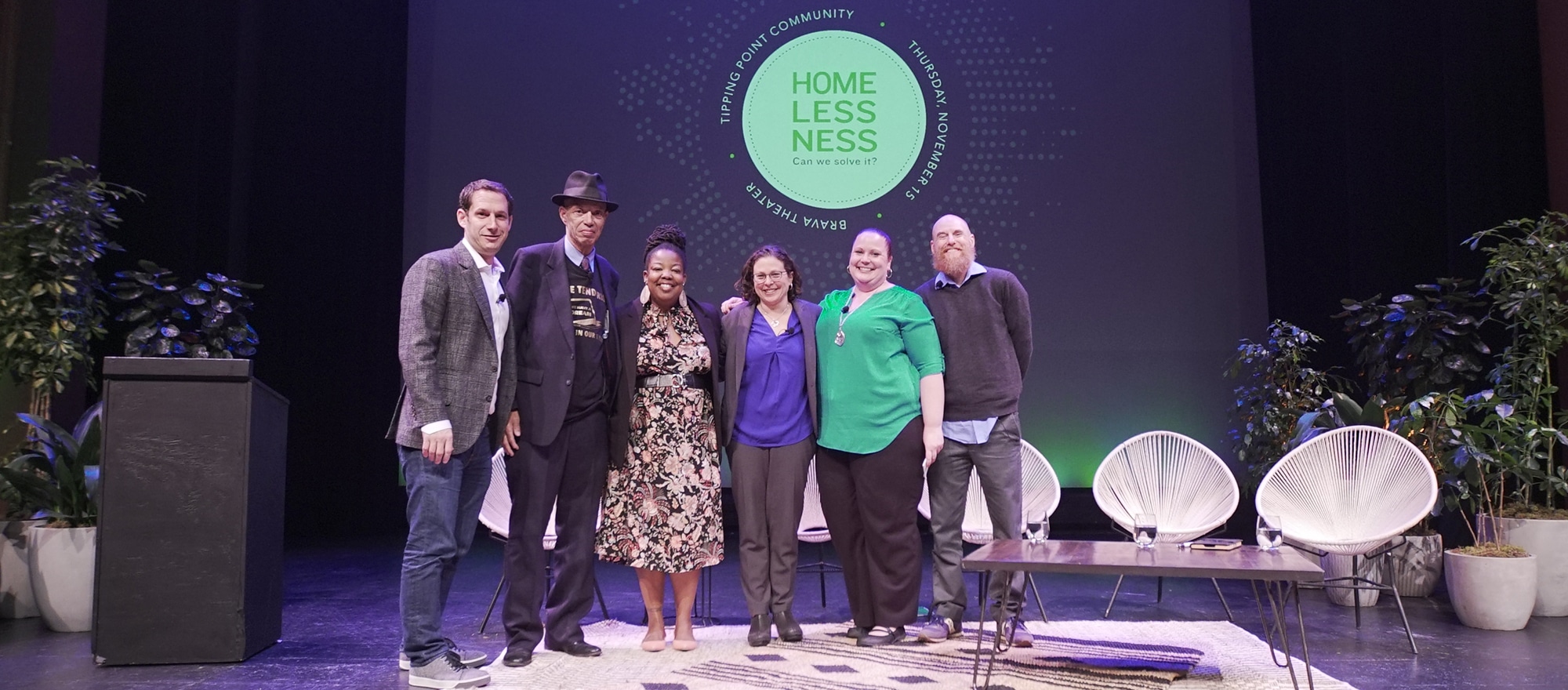Homelessness. It’s an issue that’s top of mind for all of us in the Bay Area. Whether you’re a resident, a tourist, an elected official, or someone currently experiencing homelessness — the crisis impacts us all.
Last month, Tipping Point hosted a community event to bring together experts in the field to discuss solutions. The panel featured Brian Blalock, Director of Law + Policy at Tipping Point; Dr. Margot Kushel, Director of UCSF Center for Vulnerable Populations; Tomiquia Moss, CEO of Hamilton Families (and Tipping Point Leadership Council member), and Amber Twitchell, Associate Director of On the Move, with an inspiring introduction by Del Seymour, Founder of Code Tenderloin.
While homelessness can feel like an unsolvable challenge, each of the speakers argued just the opposite. As Brian Blalock stated, “Homelessness as we know it today is the result of past policy decisions. The good news is that we got ourselves into this mess, so we can get ourselves out.”
Here are five takeaways the experts shared that are particularly enlightening on the issue and potential solutions:
- Homelessness is solvable, and we can all be part of the solution.
“I work in medicine where there are a lot of things we really don’t know how to solve, but homelessness is not one of them,” said Dr. Margot Kushel. “This is not a scientific problem, this is a problem of political will.” Permanent supportive housing has been shown to successfully house 85% of people for the long-term — including those who require a high level of services to remain stable and thrive. It’s a nationally proven solution that needs more investment here in the Bay Area. - The majority of individuals experiencing homelessness were living in San Francisco when they became homeless.
Many people assume that individuals experiencing homelessness move to the Bay Area for the weather or the services. But in fact, more than 70% of people experiencing homelessness in San Francisco were living here when they became homeless. And while it’s often believed that there are no available units of housing in the City, we have found that not to be true. For example, over the last 18 months, Tipping Point — in partnership with a nonprofit, Brilliant Corners, and San Francisco’s Department of Homelessness and Supportive Housing — has helped to house 180 people in San Francisco through a program called the Moving On Initiative. These 180 individuals were living in permanent supportive housing, but no longer needed that level of services. By helping to find landlords that would accept Section 8 housing vouchers, the program not only found homes for people, but also freed up 180 units of permanent supportive housing for people currently living on the streets. - 1 in 4 young people experiencing homelessness have been involved in the foster care system, and 50% of people experiencing homelessness first became homeless before the age of 25.
The road to homelessness can start from a young age, so any form of preventing homelessness must focus on at-risk youth. The SPARK Initiative — a program funded by Tipping Point that was developed by young people who were in the child welfare or juvenile justice systems — is aiming to do just that. “I believe in order to be successful in addressing our homelessness crisis, we have to turn to those who have lived through it and allow them to lead the charge,” said Amber Twitchell, Associate Director of VOICES/On the Move, which oversees the SPARK Initiative. Since the program launched in 2017, six peer advocates have located and helped stabilize 400 young people experiencing homelessness and helped 15 access housing. - California has 12% of the nation’s population and 20% of the country’s homeless population.
That’s more than homeless populations of Texas, Florida, Oregon, Washington, and Nevada combined. And while the numbers are dire, this community has never been more aligned around the urgency of creating and investing in solutions. More than 60% of San Franciscans voted yes on Proposition C — a measure to tax businesses in order to provide an additional $350 million for homelessness services. “Prop C gives us an opportunity to fortify our public systems so we don’t have to be concerned about the safety net,” said Tomiquia Moss. “We can engage philanthropy, the business community, and other partners to fundraise dollars for creative new solutions.” - As federal investment in vulnerable populations decreased, the homeless population increased.
The deinstitutionalization of the mentally ill in the late 1970s happened without the designation of corresponding services to support this population for independent living within the community. In the 1980s, the federal government slashed funding for subsidized housing by 80%. These cuts have never been recouped, but we can make smart policy decisions to reverse this trend. For example, SB918, legislation authored by Senator Scott Weiner and co-sponsored by Tipping Point, helped to create the first-ever office to combat youth homelessness in California. This will allow for specific goals and accountability around youth homelessness and funding to invest in critical resources.
Want to help? Here are three easy ways:
- Say hello; make eye contact with people experiencing homelessness. A simple smile can go a long way.
- If you are a landlord, or have family or friends who own apartments, we urge you to accept Section 8 vouchers. It’s easier than you may think. If interested in learning more, contact us.
- Most importantly — say YES to housing in your neighborhood. Too often, affordable housing projects are blocked because the people with the loudest voices are the ones who are against the project. We need more people to show up who are in favor of housing. It’s one powerful way we’ll start to turn the tide on the issue.
Watch the full program to hear more from our panel of experts:


